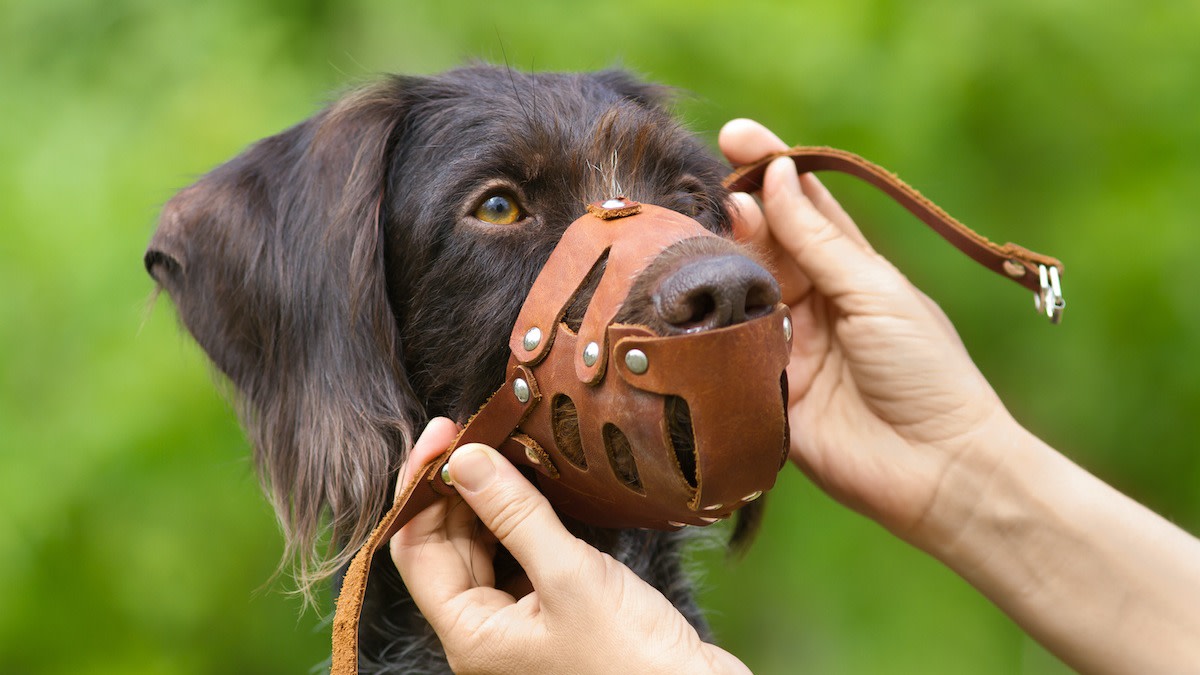Muzzle Training Overview: 3 Tips for Muzzle Training
Written by MasterClass
Last updated: Jun 1, 2022 • 4 min read
Aggressive or anxious dogs benefit from the security that muzzle training affords. Learn more about this training plan and the pros and cons of a muzzle.
Learn From the Best
What Is Muzzle Training?
Muzzle training is a behavior modification plan for dogs that uses a device that fits over the dog’s nose and mouth. There are two different types of muzzles: basket muzzles, which cover the dog’s mouth with a hard but moldable basket made of leather, wire, nylon, or rubber, and soft muzzles, which hold the dog’s mouth closed with fabric or leather. Some soft muzzles feature a mesh covering over the dog’s nose or mouth or an opening that exposes the dog’s snout while still keeping its mouth closed. Most muzzles fasten around the dog’s head with muzzle straps and a buckle or similar device.
Pros of Muzzles
Muzzles have several benefits that make them a useful dog training tool.
- Behavior modification: Muzzles prevent aggressive dogs from biting other people or animals or damaging property. Biting is often a response to stressful situations, such as a vet visit or trip to the groomer. Dogs also bite when injured or in danger, which prevents necessary and even life-saving attention. Dogs that exhibit other aggressive dog behavior, such as lunging or excessive barking, also benefit from muzzle training.
- Safety: Soft muzzles prevent dogs from hurting themselves by deliberately or accidentally ingesting dangerous objects. Muzzle training keeps dogs safe if they habitually consume items while on walks.
- Meeting local laws: Certain localities have breed-specific legislation for dog muzzles. This type of regulation requires certain dog breeds, such as pit bulls, to wear a muzzle unless they are on private property.
Cons of Muzzles
There are some cons to using muzzles in dog training. Muzzles can:
- Be restrictive: Dogs should only wear muzzles for short periods—thirty minutes or less—to prevent the risk of heat exhaustion or dehydration. By holding a dog’s mouth closed, soft muzzles prevent them from panting, which is a dog’s way of reducing its body heat. With a muzzle on, a dog is unable to eat or drink water.
- Offer only a temporary solution: Muzzles can play a part in behavior modification, but dogs require training to correct behavior problems. Muzzles only prevent dogs from acting in an aggressive manner temporarily. Your dog needs a training program, whether at home or with a veterinarian, behaviorist, or dog trainer.
- Require conditioning: Avoid using muzzles as a quick fix. Dog owners must gradually acclimate their dogs to wearing muzzles to avoid a negative connotation. This requires patience, positive association with dog treats and praise, and initially using the muzzle for only brief periods.
How to Properly Fit a Dog With a Muzzle
Here is a step-by-step guide to properly fitting a dog with a muzzle:
- 1. Acclimate the dog. Hold the muzzle out for the dog to inspect before fastening it to its face. Help the dog forge a positive association with the muzzle with plenty of dog treats and play before and after training sessions. Apply a soft treat, like peanut butter, to the outer edge of the muzzle, where your dog’s nose and face will rest.
- 2. Put the muzzle on your dog’s face. Continue using treats to help the dog feel comfortable enough to put its face in the muzzle. Avoid buckling the muzzle straps right away; let your pet get used to the feel of the muzzle before fastening it. Use treats to encourage your dog to walk with the muzzle on its face.
- 3. Fasten the muzzle. Once your dog seems acclimated to the muzzle, fasten the straps and leave the muzzle on for short periods; start with fifteen seconds for the first time and increase the duration for each subsequent wear. Make sure the straps are secure but they have some give to avoid chafing; you should be able to fit a finger between the straps and the dog’s face. Gradually work your way up to longer periods with the muzzle with the help of plentiful, high-value treats.
3 Tips for Muzzle Training
Here are some training tips to help you and your dog:
- 1. Choose the right muzzle. A comfortable, well-fitting muzzle is essential. Discomfort and injury are possible with muzzles that fit too loose or tight. Take measurements of your dog’s face before purchasing your muzzle.
- 2. Make muzzle training a positive experience. Avoid muzzling your dog in a high-stress situation to prevent your dog from associating muzzles with traumatic scenarios, making future muzzle training more difficult. Remove your dog from the stressful situation (if possible) before using the muzzle.
- 3. Avoid using muzzles as punishment. Avoid using dog muzzles to discipline your pet—the only possible outcome from that action is a negative association with the muzzle.
Want to Learn More About Training the Goodest Boy or Girl?
Your dream of having a dog who understands words like “sit,” “stay,” “down,” and—crucially— “no” is just a MasterClass Annual Membership away. The only things you’ll need to train up a well-behaved pup are your laptop, a big bag of treats, and our exclusive instructional videos from superstar animal trainer Brandon McMillan.
